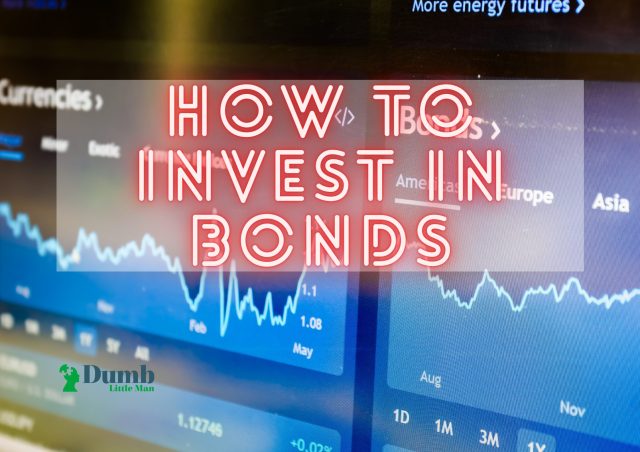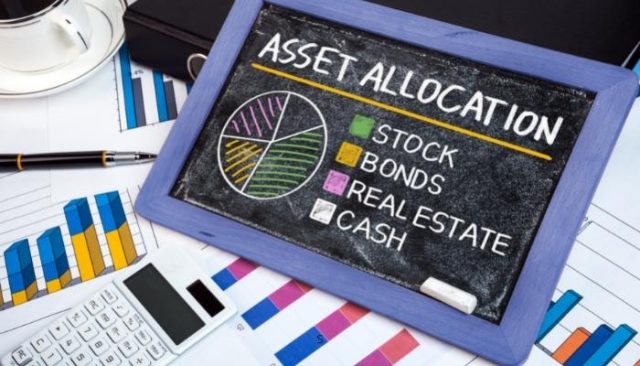How To Invest In Bonds: A Beginners Guide (2024)
By Jordan Blake
January 10, 2024 • Fact checked by Dumb Little Man

Want to jump straight to the answer? The best Stock Brokers are Tradestation and Tradier
The #1 Stocks and Forex Trading Course is Asia Forex Mentor
With rising inflation worldwide, the significance of an additional income source can't be undermined. But, there is a problem! Cryptocurrencies had a sharp rise during the past few years; Bitcoin was closing at about $70000, and Ethereum was trading at about $4800. Investors believed the surge to last forever. The success stories lured numerous investors into investing in digital wallets. However, every rise has a fall, and luck isn't always on your side.
Cryptocurrency has had a massive downfall over the last few months; Bitcoin dropped by more than 73% of its value and is now trading at a low of $19000. Similarly, Ethereum has also fallen by 75% to less than $1000. Investors suffered severe losses as part of the downfall and are looking for a way out. The stock market doesn't look like any better option. The NYSE has fallen consecutively over the last few weeks and is nearing an all-time low. Experts believe a global recession is on the cards, and the stock markets may crash.
With dying investment lines, investors can't look for another way to generate income. A possible alternative for new investors is bonds- they are practically a no-risk investment. Bonds provide a fixed rate of return on your investment with minimal risk. Once they mature, you can have your principal amount back.
In some cases, you can sell a bond at a premium if the coupon rate is higher than the ongoing market rate. Similarly, a bond may fall in value if the trading coupon rate is lower than the market rate. There is a lot more to know about investing in bonds, so let's get started. In this blog, we are going to talk about bonds and the possible strategies that can help you generate positive returns on your investment.
How to Invest in Bonds

Bonds are similar to preferred stocks; every bond has a stated rate of return paid annually to the owner. They can be transferred from one investor to another; the maturity period determines the time it takes for a bond to retire. Various institutions may issue bonds at different interest rates based on the risk involved. There are primarily four types of bonds:
- Treasury bonds are issued by the state; they usually have low-risk and long maturity because the state has the slightest chance of defaulting payments.
- Corporate bonds are issued by various organizations around the state; some credit agencies rate organizations based on their risk level. An AAA-rated bond is regarded as the safest corporate bond to invest in. Most experts don't recommend investing in bonds below BBB rating (investment grade bonds).
- Municipal bonds are issued by local bodies; these bonds are issued for local construction and may offer lesser returns.
- Foreign bonds are issued by international governments and companies; these bonds offer a high-interest rate but are prone to exchange rate risk. Investors only tend to invest in reliable foreign companies if the interest rates are considerably higher than those offered in their home country.
Bonds aren't traded on the stock exchange; the issuer shall decide how the bonds will be sold. Usually, corporate bonds are available with brokers and are traded on over-the-counter exchanges. The interest rates offered on bonds are dependent on various risk factors. Usually, bonds include an inflation risk premium to account for changes in inflation over the bond's life.
A higher inflation rate may turn the real rate of return negative; therefore, an additional rate is offered over the real rate of return. Similarly, corporate bonds may have different default risk premiums based on their credit rating; a low-rated bond has a higher stated rate to suffice the additional risk.
Finally, bonds are supposed to be liquid- they should be convertible at their original price at any instant. If a bond has low liquidity, investors may require an additional return for the added risk. A treasury bond is regarded as the safest investment option; it is highly liquid and doesn't have any default risk premium. However, the bonds are still prone to changes in the inflation rate; therefore, the interest rate includes the real risk-free rate and an inflation premium.
6 Steps Bond Allocation Strategy
#1. Learn the Basics

Education is an integral part of investments; if you aren't knowledgeable about an asset, there is a fair chance of incurring losses. Investing in bonds is similar to any other business; with the correct information, you can enjoy higher returns without additional risks.
Every issuer has a fixed rate for their bond; bonds with longer maturity dates usually offer additional returns due to interest rate risk. However, they keep your bond funds for a longer interval, and you can't invest them in other more profitable options.
As an investor, your first goal should be to understand how the bond market works. You should have an in-depth understanding of the type of bonds and which of them will suit your risk tolerance.
Multiple youtube channels provide educational content about US bonds; they cater to a wide range of subjects that may affect your final decisions. The right educational source can be a game-changer for your investment portfolio and help generate positive returns.
#2. Choose an Investment Strategy

You must identify your investment strategy before investing your funds in a bond. Usually, bonds aren't as complex as stocks; they aren't traded on a stock exchange, and their trading value doesn't change until the central bank changes the market rate. Your trading strategy will be based on two things- risk and reward.
Risk is the chance of losing your principal amount to an investment; government bonds are the most reliable, and state-issued bonds won't default in most cases. If you are looking to protect your money from inflation and earn a small return, a treasury bond is the right choice. The bond will repay your investment in full at the maturity date, and your bond funds will be protected from any state and local taxes.
However, treasury bonds pay the least interest rates in trading markets; hence, the investment has a low reward, and you can't mainly rely on their return as passive income. On the other hand, low investment-grade bonds pay considerably higher returns.
Before the 2008 recession, BBB bonds paid about 10% more returns than treasury bonds. You need to base your strategy on your risk tolerance and reward expectations.
#3. Determine Asset Allocation

Asset allocation refers to dividing your portfolio into multiple assets to attain the best results with reduced risks. Although bonds aren't as risky as stocks or crypto, their return is often comparatively lower. Most investors would be looking for better returns on their investment. Hence, buying bonds for your entire investment isn't always a great choice.
Experts suggest investors divide their investments based on their age. A young individual has higher risk tolerance and better reward expectations. On the contrary, a retired professional may look for consistent interest payments on their investments. Hence, your age determines the percentage of your investment that goes to bonds.
A 25-aged investor should invest no more than 25% of their investment in bonds; they will have a fixed income for the bond investment and still have the margin to attain better results. Today, various Robo-advisors have developed intelligent methods to diversify your investments. They automate the investment procedure and help you achieve your financial goals.
#4. Open an Investment Account

Once you are clear on your investing strategy and asset allocation, the next step is to dive into the real investing world and get things started. The next step is to find the best brokerage for your investment account. Here are some traits of the ideal investment account:
- Brokerage fees play an essential part in reaching a final decision. Various American brokerages offer high features with minimal management fees. You should select a brokerage account with a wide range of indicators and low charges to get a hold of your profits.
- Asset diversification is also an essential aspect of investment; you should select an investment account that offers a wide range of digital assets. Various American brokers offer their users to invest in bonds, crypto, stocks, options, and ETFs.
- Educational resources may also come in handy for making the right decisions. Therefore, once you research the brokerage account, look for its key features and resources.
#5. Choose your Bonds

The next step is to begin your research and invest; your investing strategy will provide the basis to select the perfect bonds for you. Ideally, your brokerage will pass on crucial information about bond prices, issues and sales; the information makes investing easy, and you won't have to struggle to research the best bonds.
The investment horizon considers how long you plan to invest in the asset. Bonds usually have a fixed maturity period; an investor would receive a fixed income from the investments over the bond's life.
Usually, investors don't prefer high-yielding short-term bonds as they come with reinvestment risk. Despite high returns, a short-term bond may result in a low cumulative profit if interest rates decrease in the future.
While expected return is critical in the bond selection, the bond issuer is no lesser. A higher-yielding bond may result in a principal loss if the authority fails to repay your bonds. You must ensure your bond issuer has a reliable rating and a reputable record amongst previous investors. Your investment account may provide valuable statistics and reviews regarding each bond.
#6. Rebalance your Portfolio

If your investment account has an automated bond fund, you won't have to worry about rebalancing your portfolio. However, if it doesn't, you should learn to rebalance before it's too late.
Rebalancing refers to resetting your investment portfolio with profitable assets and taking the loss-makers away. Over time, a good asset may turn less fortunate due to market conditions. Hence, keeping it in the portfolio and adding to losses isn't beneficial.
Rebalancing your portfolio will curb the problem and help you make the most of your bond investments. Market interest rates are changed frequently in a current economy; therefore, a rise in interest rates would mean new bonds result in better interest payments than the former ones. Hence, you may need to add some high-paying bonds to your portfolio to generate better returns.
You must monitor your investment performance over the period; sometimes, you may need to withdraw from a vulnerable stock investment and add to your bond portfolio. Sometimes, it may go entirely opposite. Hence, you should always be prepared to make the decision that helps your portfolio grow.
Featured Investing Broker of 2024
| Broker | Best For | More Details |
|---|---|---|
 | Advanced Non US Traders Read Review | securely through Avatrade website |
 | Intermediate Non-US Traders Read Review | securely through FXCC website |
Overall Broker | securely through Forex.com website | |
 | Professional Forex Traders Read Review | securely through Interactive Brokers website |
| Broker | Best For | More Details |
|---|---|---|
 | Advanced Traders Read Review | securely through Tradestation website |
 | Intuitive Platforms Read Review | securely through Tradier website |
 | Powerful Services at a Low Cost | securely through Tradezero website |
 | Professional Forex Traders Read Review | securely through Interactive Brokers website |
Best Stocks and Forex Training Course

If you are a trader looking to fast-track your journey into earning six-figure trades is a mathematically proven model with a very low risk-free profit approach, and your best forex course is the One Core Program.
The One Core Program is a course with a cumulative 20 years of trading markets by Ezekiel Chew from the Asia Forex Mentor brand. It’s the main course for retail traders, institutional traders, and other market participants is taken from the introduction to the advanced analytical trading strategy to approach the financial markets.
Lastly, the One Core Program builds on a holistic approach to trading – it’s the main reason many traders end their search for credible skills by taking the One Core Program. In a nutshell, it tackles the psychological approach to trading, beating the market through the thorough analysis of price action as part of a trading strategy. It also lays emphasis on picking a few expected trades with high odds of winning.
| RECOMMENDED TRADING COURSE | REVIEW | VISIT |
|---|---|---|
 | #1 Forex, Crypto and Stocks trading course. Ranked most comprehensive by Investopedia and Best by Benzinga. Free to Try! |  |
Conclusion: How to Invest in Bonds

In a rapidly changing world, it is vital to have multiple income streams; bonds are a reliable investment line that can provide consistent returns with minimal risks. There are various kinds of bonds. Treasury bonds are regarded as the safest options as the state issues them; nonetheless, you will still have to pay federal income tax on returns from these bonds.
Corporate bonds are comparatively risky, but they provide considerably better returns. The credit agencies can provide helpful ratings regarding individual bonds and their reliability. You must use the resources fully to generate the best returns.
Investing involves risk, and bonds aren't different. Your bonds may lose market value if interest rates rise beyond the coupon rate. Similarly, if the company's rating falls in the trustability index, its liquidity would decrease. The only way to protect your investment is to be vigilant in researching bonds.
You shouldn't shy from reading individual bonds in detail; various websites publish reviews about different bonds, and they may come in handy in determining your final decision.
How to Invest in Bonds FAQs
Are bonds a good investment?
Every investment can be judged based on its risk-reward ratio. The reward must overpower the perceived risk for any investment to be considered ‘good.' In the case of bonds, an investor gets a fixed income yearly; the returns are predictable, and usually, the risk is minimal.
A state-issued bond has little chance of default; similarly, reliable companies, like Microsoft, look strong financially and may not default on interest payments. Nonetheless, the returns are often low compared to other modes of investment.
Bonds can be considered a good investment for people with a low-risk appetite. However, stocks and cryptocurrency are better options if you are looking for quick returns on low investment.
Can you lose money in a bond?
Bonds are a considerably safe investment; you won't lose your nominal investment in most cases. A relevant study suggests that only 4% of the bonds issued between 1981 to 2020 defaulted. Most of the defaults occurred during the global recession, and we can expect the default rate to be lower if good economic conditions prevail.
Nonetheless, investors usually lose money in terms of opportunity costs. Bonds are long-term investments, and there may be several critical changes in the economy that reduce the real return of the bonds.
For instance, a 10% 25-year bond may look like a good option with an ongoing market rate of 8%. You may even buy it at a premium, but if the market rate rises after some years, the bond's market value shall decline.
Hence, the bond will be traded below its face value at a discount. Therefore, an investor can't get the whole principal amount by selling the asset. Instead, they will have to hold the bond till its maturity date to recover the par value.
Jordan Blake
Jordan Blake is a cultural commentator and trending news writer with a flair for connecting viral moments to the bigger social picture. With a background in journalism and media studies, Jordan writes timely, thought-provoking content on everything from internet challenges and influencer scandals to viral activism and Gen Z trends. His tone is witty, observant, and sharp—cutting through the noise to bring readers the “why” behind the “what.” Jordan’s stories often go deeper than headlines, drawing links to pop culture, identity, and digital behavior. He’s contributed to online media hubs and social commentary blogs and occasionally moderates online panels on media literacy. When he’s not chasing the next big trend, Jordan is probably making memes or deep-diving into Reddit threads. He believes today’s trends are tomorrow’s cultural history—and loves helping readers make sense of it all.













